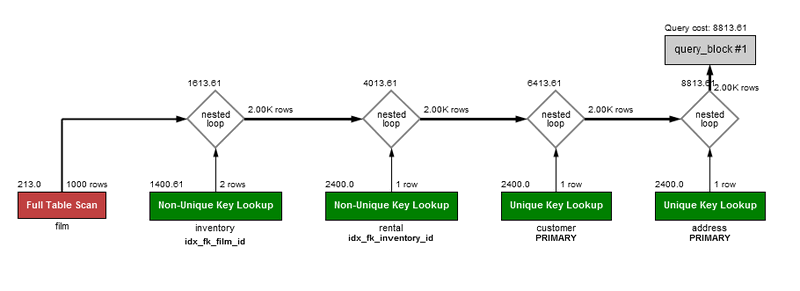The visual explain feature generates and displays a visual
representation of the MySQL EXPLAIN
statement by using extended information available in the extended
JSON format. MySQL Workbench provides all of the
EXPLAIN formats for executed queries including
the raw extended JSON, traditional format, and visual query plan.
To view a visual explain execution plan, execute your query from
the SQL editor and then select Execution
Plan within the query results tab. The execution plan
defaults to Visual Explain, but it also
includes a Tabular Explain view that is
similar to what you see when executing
EXPLAIN in the MySQL client. For
information about how MySQL executes statements, see
Optimizing Queries with EXPLAIN.
The order of execution in a visual explain diagram is bottom to top and left to right. The diagram examples that follow provide an overview of the graphic, textual, and informational conventions used to represent aspects of the visual explain plans. For specific information, see:
The visual explain diagram in the first figure shows a visual representation of the following query.
SELECT CONCAT(customer.last_name, ', ', customer.first_name)
AS customer, address.phone, film.title FROM rental
INNER JOIN customer ON rental.customer_id = customer.customer_id
INNER JOIN address ON customer.address_id = address.address_id
INNER JOIN inventory ON rental.inventory_id = inventory.inventory_id
INNER JOIN film ON inventory.film_id = film.film_id
WHERE rental.return_date IS NULL
AND rental_date + INTERVAL film.rental_duration DAY < CURRENT_DATE()
LIMIT 5;
The next visual explain diagram shows the visual representation
of a query that contains a hash join. Prior to MySQL Workbench
8.0.22, a hash join was represented by a block nested
loop diamond for queries executed by MySQL 8.0.19 (or
earlier).
SELECT first_name, last_name
FROM actor
FULL JOIN film_actor
WHERE '' = film_actor.actor_id;Graphic Conventions
Standard Boxes: tables
Rounded boxes: operations such as GROUP and SORT
Framed boxes: subqueries
Diamonds: joins
Textual and Informational Conventions
Standard text below boxes: table (or alias) name
Bold text below boxes: key/index that was used
Number in top right of a box: number of rows used from the table after filtering
Number in top left of a box: relative cost of accessing that table (requires MySQL 5.7 or higher)
Number to the right of nested loop (or hash join) diamonds: number of rows produced by the JOIN
Number above the diamonds: relative cost of the JOIN (requires MySQL 5.7 or higher)
The following table shows the associated colors and descriptions used in the visual explain diagram. For more information about cost estimates, see The Optimizer Cost Model.
Table 7.1 Visual Explain Diagram Information
| System Name | Color | Text on Visual Diagram | Tooltip Related Information |
|---|---|---|---|
| SYSTEM | Blue | Single row: system constant | Very low cost |
| CONST | Blue | Single row: constant | Very low cost |
| EQ_REF | Green | Unique Key Lookup | Low cost -- The optimizer is able to find an index that it can use to retrieve the required records. It is fast because the index search directly leads to the page with all the row data |
| REF | Green | Non-Unique Key Lookup | Low-medium -- Low if the number of matching rows is small; higher as the number of rows increases |
| FULLTEXT | Yellow | Fulltext Index Search | Specialized FULLTEXT search. Low -- for this specialized search requirement |
| REF_OR_NULL | Green | Key Lookup + Fetch NULL Values | Low-medium -- if the number of matching rows is small; higher as the number of rows increases |
| INDEX_MERGE | Green | Index Merge | Medium -- look for a better index selection in the query to improve performance |
| UNIQUE_SUBQUERY | Orange | Unique Key Lookup into table of subquery | Low -- Used for efficient Subquery processing |
| INDEX_SUBQUERY | Orange | Non-Unique Key Lookup into table of subquery | Low -- Used for efficient Subquery processing |
| RANGE | Orange | Index Range Scan | Medium -- partial index scan |
| INDEX | Red | Full Index Scan | High -- especially for large indexes |
| ALL | Red | Full Table Scan | Very High -- very costly for large tables, but less of an impact for small ones. No usable indexes were found for the table, which forces the optimizer to search every row. This could also mean that the search range is so broad that the index would be useless. |
| UNKNOWN | Black | unknown | Note: This is the default, in case a match cannot be determined |

